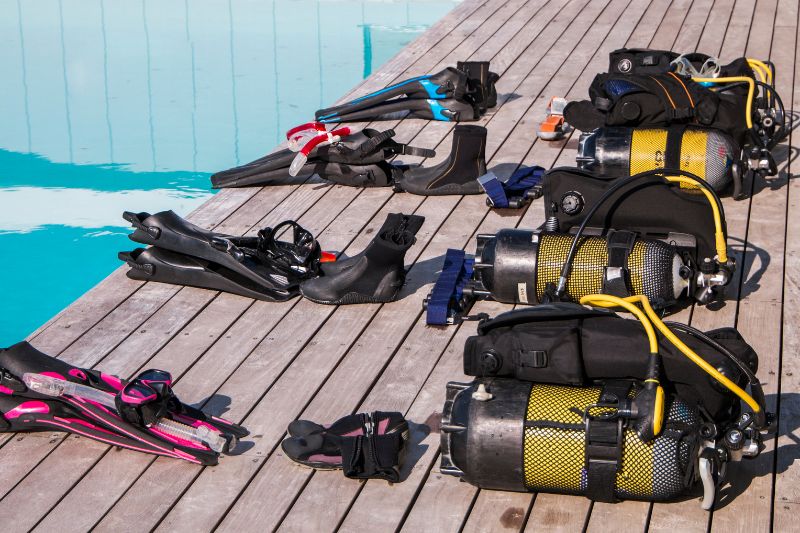Maintaining your water sports gear is a must for ensuring safety, extending the lifespan of your equipment, and getting the most out of your water adventures.
Here are the 15 best practices for keeping your gear in top shape:
Rinse with Fresh Water
After every use, rinse your water sports gear with fresh water to remove salt, sand, and other debris. Saltwater can cause corrosion and degrade materials over time, while sand can create abrasion.
- Salt and Sand Removal:
- Saltwater is highly corrosive and can damage metal components.
- Sand can cause abrasion and wear on surfaces, affecting the performance and longevity of your gear.
- Chlorine Residue:
- If you’ve been using your gear in a pool, rinsing removes chlorine, which can degrade materials over time.
- Chlorine can also cause discoloration and weaken the structural integrity of your gear.
Dry Thoroughly
Make sure your gear is completely dry before storing it. Dampness can lead to mold and mildew, which not only damage your equipment but can also pose health risks. Hang your gear in a well-ventilated area away from direct sunlight.
Store Properly

Store your gear in a cool, dry place. Avoid areas with extreme temperatures or high humidity, as these conditions can weaken materials and reduce the lifespan of your equipment. Use protective covers or bags for added protection.
- Cool, Dry Storage:
- Extreme temperatures can cause materials like rubber and neoprene to become brittle and crack.
- High humidity can lead to mold and mildew growth, damaging your equipment.
- Protective Covers:
- Use bags or covers to shield gear from dust, pests, and UV light.
- Covers also help in organizing and protecting gear during transport.
Regular Inspections
Regularly inspect your gear for signs of wear and tear. Look for cracks, frayed edges, or any other damage that could compromise safety. Early detection of issues allows for timely repairs and replacements.
Lubricate Moving Parts

For gear with moving parts, such as windsurfing rigs or diving regulators, regular lubrication is essential. Use manufacturer-recommended lubricants to ensure smooth operation and prevent rust.
Avoid Harsh Chemicals
Avoid using harsh chemicals or cleaners on your water sports gear. Instead, use mild soap and water. Harsh chemicals can weaken materials and cause discoloration.
Check Fastenings and Seals
Ensure that all fastenings and seals are in good condition. This includes zippers, buckles, and Velcro. Replace any damaged parts promptly to maintain the functionality and safety of your gear.
- Zipper Care:
- Keep zippers clean and free of sand and salt to prevent them from sticking or corroding.
- Use zipper lubricants specifically designed for water sports gear to ensure smooth operation.
- Velcro Maintenance:
- Remove any debris from Velcro to maintain its sticking power.
- Replace worn Velcro strips as needed to ensure secure fastening of your gear.
Mind the Sun

While drying your gear is essential, prolonged exposure to direct sunlight can damage materials, especially rubber and plastic components. Dry your gear in the shade whenever possible.
Properly Inflate and Deflate
For inflatable gear like paddleboards and kayaks, follow proper inflation and deflation procedures. Overinflation can cause bursts, while underinflation can impact performance and safety. Always use a pressure gauge.
Use Protective Gear
Invest in protective gear such as bags and covers for your equipment. These can help prevent scratches, dents, and other damage during transport and storage.
Clean and Condition Wetsuits

Wetsuits require special care. Rinse them with fresh water, use wetsuit shampoo for cleaning, and occasionally condition with specific wetsuit products to maintain flexibility and integrity.
- Wetsuit Shampoo:
- Use specialized wetsuit shampoo to clean and remove salt, chlorine, and other residues.
- Regular cleaning prevents buildup that can cause odors and material degradation.
- Conditioning:
- Occasionally use wetsuit conditioner to maintain the neoprene’s flexibility and elasticity.
- Conditioning helps prevent cracking and extends the life of the wetsuit.
Handle with Care
Always handle your gear with care. Avoid dragging, dropping, or stepping on equipment, as these actions can cause significant damage. Teach proper handling techniques to anyone who uses your gear.
Store in the Off-Season
During off-season periods, give your gear a thorough cleaning and check-up before storing it. Use breathable covers to protect from dust and pests, and avoid compressing items that need to maintain their shape.
Follow Manufacturer Guidelines
Always follow the maintenance and care guidelines provided by the manufacturer. These guidelines are specific to the materials and construction of your gear and can significantly extend its lifespan.
Professional Servicing

At least once a year, have your gear professionally serviced, especially complex items like diving regulators or jet skis. Professionals can detect and fix problems that might not be visible to the untrained eye.
- Annual Check-Up:
- Schedule an annual professional servicing for complex equipment like diving regulators, jet skis, and other motorized gear.
- Regular professional maintenance ensures all components are in good working order and can prevent unexpected failures.
- Expert Inspection:
- Professionals can identify and repair issues that might not be apparent to the untrained eye, ensuring optimal performance and safety.
- Professional servicing often includes pressure testing and other diagnostics to ensure reliability.

